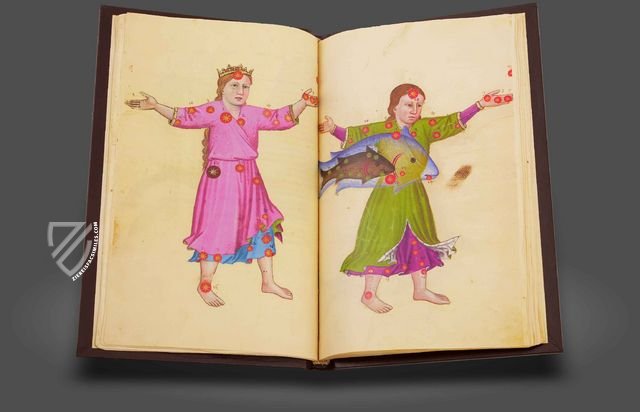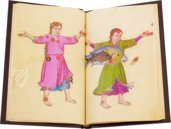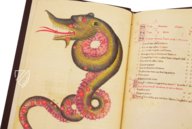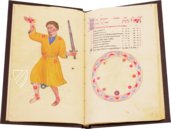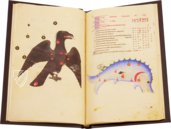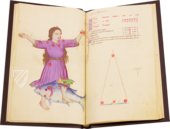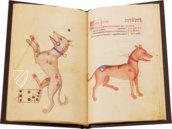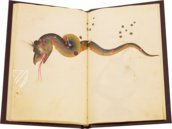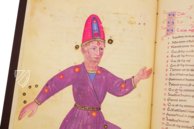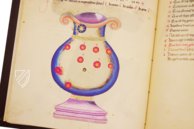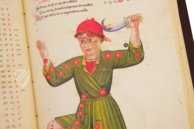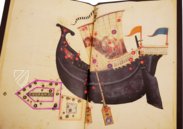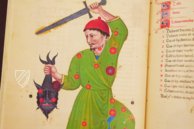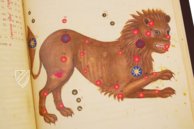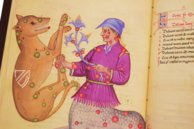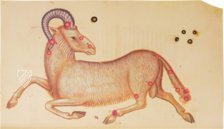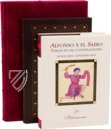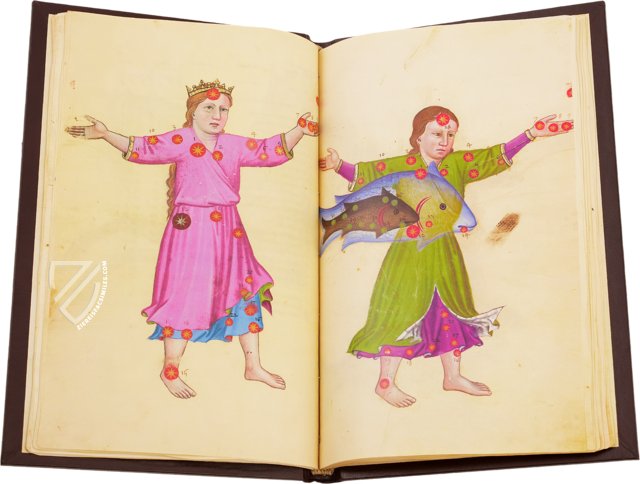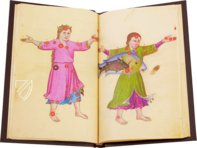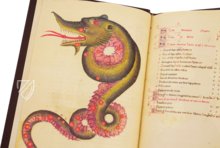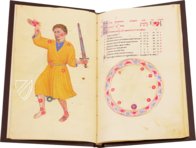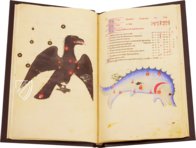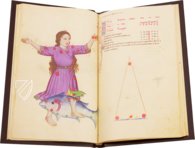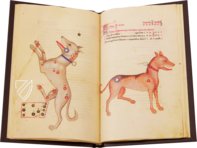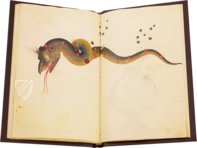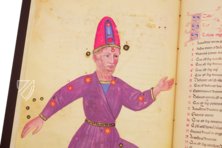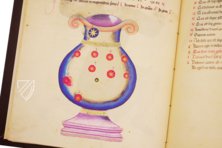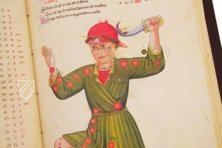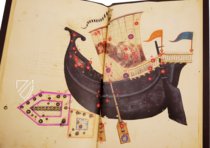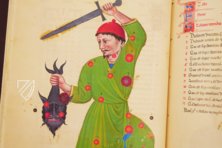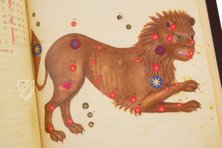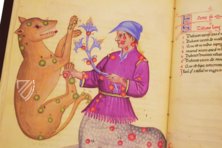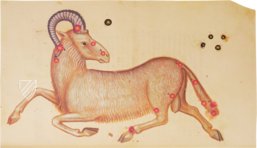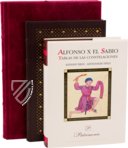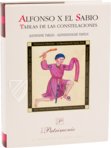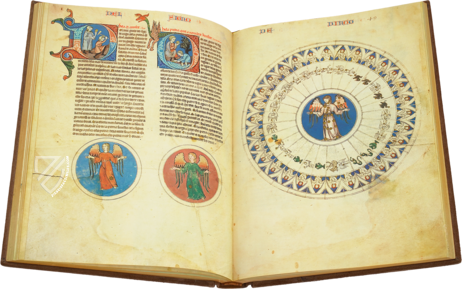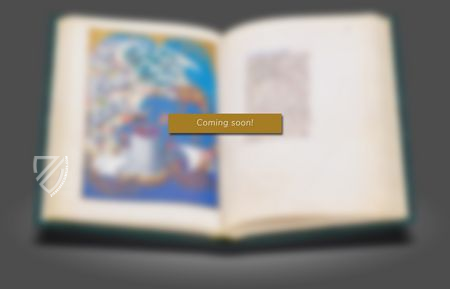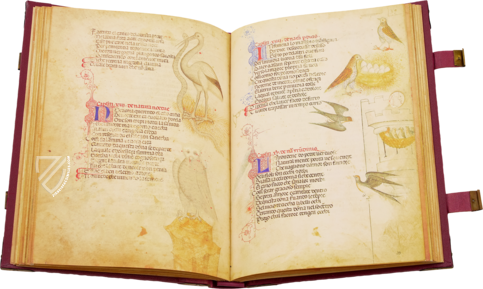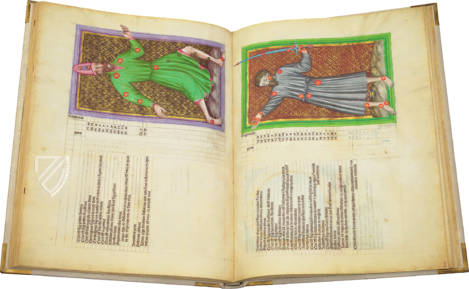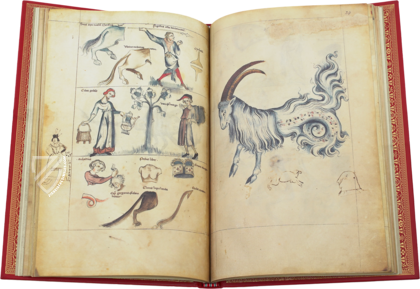Book of Fixed Stars of Alfonso the Wise
(3,000€ - 7,000€)
The Book of Fixed Stars of the Castilian King, Alfonso X, is a central work of European astronomy. It contains the ground-breaking Alfonsine Tables, produced at the behest of Alfonso X (1221–84) “the Wise”, renowned as a royal patron of the sciences (especially astronomy) in the late 13th century. The improvements to Ptolemaic Cosmology, established by Jewish scholars in Toledo, became widespread throughout Europe and were decisive up until the 16th century. The manuscript from the Berliner Kupferstichkabinett illustrated the astronomical charts with wonderful miniatures, which were presumably finished in Italy in the 14th century.
Book of Fixed Stars of Alfonso the Wise
The Book of Fixed Stars of the Castilian King, Alfonso X, is a central work of European astronomy. It contains the ground-breaking Alfonsine Tables, produced at the behest of Alfonso X (1221–84) “the Wise”, renowned as a royal patron of the sciences (especially astronomy) in the late 13th century. The improvements to Ptolemaic Cosmology, established by Jewish scholars in Toledo, became widespread throughout Europe and were decisive up until the 16th century. The manuscript from the Berliner Kupferstichkabinett illustrated the astronomical charts with wonderful miniatures, which were presumably finished in Italy in the 14th century.
The Illustrated Edition of a Famous Astronomic Work
The comprehensive, 100-page manuscript is equipped with 50 extremely rich whole-page miniatures. Mysterious astronomical depictions, symbols of zodiac signs, animals, people, and mythical creatures illustrate the astronomical charts with calculations of their location in the sky. The explanatory miniatures are presented in bright colors, partly embellished with gold and silver, alongside the Latin text. The illuminated manuscript of the Alfonsine Tables from the Berliner Kupferstichkabinett offers the opportunity to delve into the birth of European astronomy, while at the same time enjoying miniatures of the highest quality.
Groundbreaking Work of European Astronomy
The basis of the manuscript was laid by Alfonso X, so named the Wise, King of Castile and Leon. Alfonso X was – as his byname betrays – well-known as a scientist. Thus he patronized many literary works, as well as composing poetic and scientific works himself. He founded a school for translation in Toledo, wherein texts from Arabic and Jewish scientists in Europe could be transcribed. The Castilian King is especially famous to this day as a patron of Astronomy. Between 1252 and 1270, he optimized the Ptolemaic Cosmology, which is known today as the Alfonso Tables. Ptolemaic Cosmology was made known to Alfonso X through Spain’s Moors. They are composed in a variety of tables for the calculation of the position of the Sun, Moon, and the five then-known Planets (Mercury, Venus, Mars, Jupiter, and Saturn). The state of this science of was improved upon through the sponsorship of the King. Thus, the Alfonsine Tables exhibit the special feature of being the very first European manuscript to mention the Andromeda-Galaxy, which was still unknown to Ptolemaic astronomy.
A Cross-Cultural Work
Alongside that, the charts were also influenced by al-Sufi (903–986) and his work The Book of Fixed Stars from ca. 964, which is the earliest illustrated book from the Islamic world. Two Jewish scholars from Toledo were responsible for the new Alfonsine Tables: Yehuda Den Mose and Isaac Ben Sid. Originally, the work was composed in Castilian, but a translation into Latin was made after that due to its grandiose reception in all of Europe. These charts were counted amongst the most influential astronomical works in Europe up to the 16th century. Testimony places this manuscript’s origins in 14th century Italy.
Codicology
- Alternative Titles
- Tablas de las Constelaciones de Alfonso X el Sabio
Buch der Fixsterne Alfons’ X. des Weisen
Tables des Constellations d’Alphonse X le Sage
Tavola delle Costellazioni di Alfonso X il Saggio
Tábuas das Constelações de Afonso X o Sábio - Size / Format
- 100 pages / 38.0 × 24.0 cm
- Origin
- Italy
- Date
- 13th or 14th century
- Style
- Genre
- Language
- Illustrations
- 50 gold and silver adorned full-page miniatures in bold colors and countless fleuronnée initials
- Patron
- Perhaps Alfonso X, the Wise (1221–1284), King of Castile, León and Galicia
Book of Fixed Stars of Alfonso the Wise
Orion
Here we see Orion, a mythological hunter associated with the constellation of the same name. He has the lagobolon, a cudgel used for hunting, held aloft in his right hand. Rather than showing him holding a lion’s hide, this 14th century Italian miniature shows him with a long left sleeve in the Turkish style and demonstrates other Oriental influences, which are most recognizable in the hilt of his hunting sword. Each star is numbered for identification in a key on the page facing it.
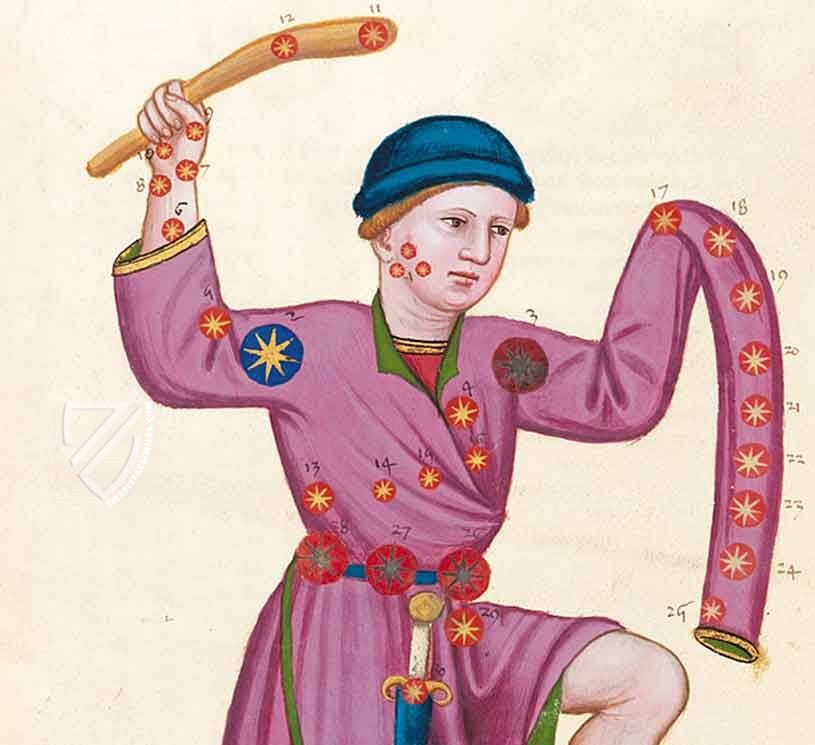
Book of Fixed Stars of Alfonso the Wise
Sagittarius
This splendid Italian miniature is a testimony to the great and lasting impact King Alfonso X of Castile had as a student of the stars. Aside from containing the famous Alfonsine Tables and groundbreaking discoveries for astronomy, it also has marvelously artistic depictions of zodiac symbols associated with the original Ptolemaic constellations, such as this lovely depiction of Sagittarius.
Golden, eight-pointed stars in red medallions represent the constellation. The figure is depicted in detail, from his headband blowing in the wind to his strawberry blonde curls to the details of his pink tunic with blue shadows, which is trimmed with cloth of gold. Finally, the equine part of the figure rears aggressively as he shoots.
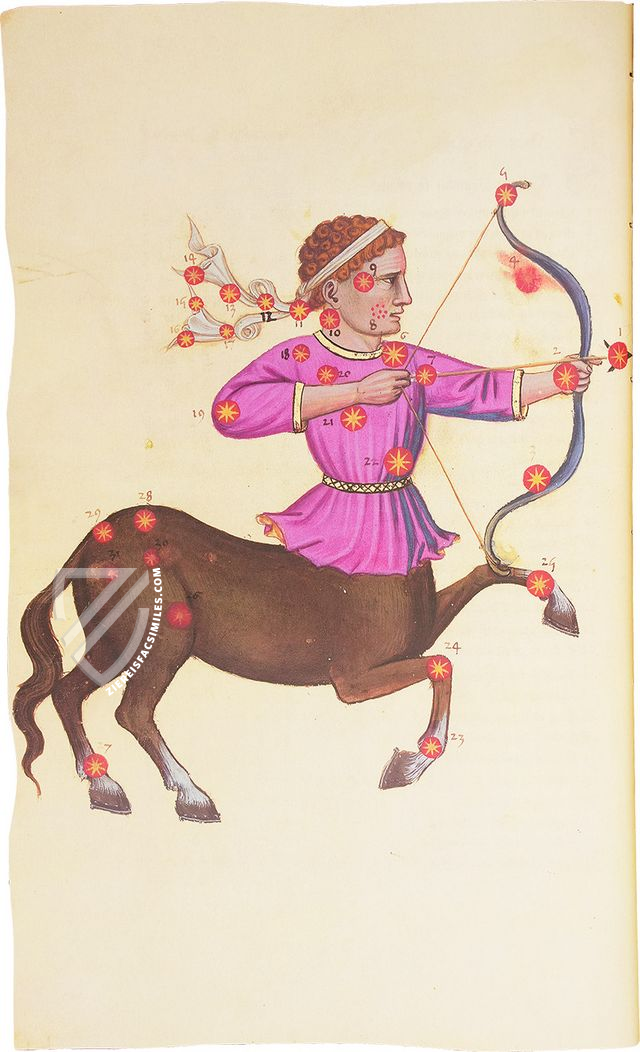
#1 Tablas de las Constelaciones de Alfonso X el Sabio
Languages: English, German, Spanish
(3,000€ - 7,000€)
- Treatises / Secular Books
- Apocalypses / Beatus
- Astronomy / Astrology
- Bestiaries
- Bibles / Gospels
- Chronicles / History / Law
- Geography / Maps
- Saints' Lives
- Islam / Oriental
- Judaism / Hebrew
- Single Leaf Collections
- Leonardo da Vinci
- Literature / Poetry
- Liturgical Manuscripts
- Medicine / Botany / Alchemy
- Music
- Mythology / Prophecies
- Psalters
- Other Religious Books
- Games / Hunting
- Private Devotion Books
- Other Genres
- Afghanistan
- Armenia
- Austria
- Belgium
- Colombia
- Croatia
- Czech Republic
- Denmark
- Egypt
- Ethiopia
- France
- Germany
- Hungary
- India
- Iran
- Iraq
- Israel
- Italy
- Japan
- Luxembourg
- Mexico
- Morocco
- Netherlands
- Peru
- Poland
- Portugal
- Russia
- Serbia
- Spain
- Sri Lanka
- Sweden
- Switzerland
- Syria
- Turkey
- Ukraine
- United Kingdom
- United States
- Uzbekistan
- Aboca Museum
- Ajuntament de Valencia
- Akademie Verlag
- Akademische Druck- u. Verlagsanstalt (ADEVA)
- Aldo Ausilio Editore - Bottega d’Erasmo
- Alecto Historical Editions
- Alkuin Verlag
- Almqvist & Wiksell
- Amilcare Pizzi
- Andreas & Andreas Verlagsbuchhandlung
- Archa 90
- Archiv Verlag
- Archivi Edizioni
- Arnold Verlag
- ARS
- Ars Magna
- ArtCodex
- AyN Ediciones
- Azimuth Editions
- Badenia Verlag
- Bärenreiter-Verlag
- Belser Verlag
- Belser Verlag / WK Wertkontor
- Benziger Verlag
- Bernardinum Wydawnictwo
- BiblioGemma
- Biblioteca Apostolica Vaticana (Vaticanstadt, Vaticanstadt)
- Bibliotheca Palatina Faksimile Verlag
- Bibliotheca Rara
- Boydell & Brewer
- Bramante Edizioni
- Brepols Publishers
- British Library
- C. Weckesser
- Caixa Catalunya
- Canesi
- CAPSA, Ars Scriptoria
- Caratzas Brothers, Publishers
- Carus Verlag
- Circulo Cientifico
- Club Bibliófilo Versol
- Club du Livre
- CM Editores
- Collegium Graphicum
- Collezione Apocrifa Da Vinci
- Comissão Nacional para as Comemorações dos Descobrimentos Portugueses
- Coron Verlag
- Corvina
- CTHS
- D. S. Brewer
- De Agostini/UTET
- De Schutter
- Deuschle & Stemmle
- Deutscher Verlag für Kunstwissenschaft
- DIAMM
- Droz
- E. Schreiber Graphische Kunstanstalten
- Ediciones Boreal
- Ediciones Grial
- Ediclube
- Edições Inapa
- Edilan
- Editalia
- Edition Georg Popp
- Edition Leipzig
- Edition Libri Illustri
- Editiones Reales Sitios S. L.
- Éditions de l'Oiseau Lyre
- Editions Medicina Rara
- Editorial Casariego
- Editorial Mintzoa
- Editrice Antenore
- Editrice Velar
- Edizioni Edison
- Egeria, S.L.
- Eikon Editores
- Electa
- Enciclopèdia Catalana
- Eos-Verlag
- Ephesus Publishing
- Eugrammia Press
- Extraordinary Editions
- Fackelverlag
- Facsimila Art & Edition
- Facsimile Editions Ltd.
- Facsimilia Art & Edition Ebert KG
- Faksimile Verlag
- Feuermann Verlag
- Folger Shakespeare Library
- Franco Cosimo Panini Editore
- Friedrich Wittig Verlag
- Fundación Hullera Vasco-Leonesa
- G. Braziller
- Gabriele Mazzotta Editore
- Gebr. Mann Verlag
- Gesellschaft für graphische Industrie
- Getty Research Institute
- Giovanni Domenico de Rossi
- Giunti Editore
- Graffiti
- Grafica European Center of Fine Arts
- Guido Pressler
- Guillermo Blazquez
- H. N. Abrams
- Harrassowitz
- Helikon
- Hendrickson Publishers
- Henning Oppermann
- Herder Verlag
- Hes & De Graaf Publishers
- Hoepli
- Hortus Deliciarum
- Houghton Library
- Hugo Schmidt Verlag
- Idion Verlag
- Il Bulino, edizioni d'arte
- ILte
- Imago
- Insel Verlag
- Instituto de Estudios Altoaragoneses
- Instituto Nacional de Antropología e Historia
- Istituto dell'Enciclopedia Italiana - Treccani
- Istituto Ellenico di Studi Bizantini e Postbizantini
- Istituto Geografico De Agostini
- Istituto Poligrafico e Zecca dello Stato
- Italarte Art Establishments
- J. Thorbecke
- Jan Thorbecke Verlag
- Johnson Reprint Corporation
- Jugoslavija
- Karl W. Hiersemann
- Kasper Straube
- Kaydeda Ediciones
- Konrad Kölbl Verlag
- Kurt Wolff Verlag
- La Liberia dello Stato
- La Linea Editrice
- La Meta Editore
- Lambert Schneider
- Landeskreditbank Baden-Württemberg
- Leo S. Olschki
- Les Incunables
- Library of Congress
- Libreria Musicale Italiana
- Lichtdruck
- Lito Immagine Editore
- Lumen Artis
- Lund Humphries
- M. Moleiro Editor
- Maison des Sciences de l'homme et de la société de Poitiers
- Manuscriptum
- Maruzen-Yushodo Co. Ltd.
- MASA
- McGraw-Hill
- Militos
- Millennium Liber
- Müller & Schindler
- National Library of Wales
- Neri Pozza
- Nova Charta
- Oceanum Verlag
- Odeon
- Orbis Mediaevalis
- Orbis Pictus
- Österreichische Staatsdruckerei
- Oxford University Press
- Pageant Books
- Parzellers Buchverlag
- Patrimonio Ediciones
- Pattloch Verlag
- PIAF
- Pieper Verlag
- Plon-Nourrit et cie
- Prestel Verlag
- Princeton University Press
- Prisma Verlag
- Priuli & Verlucca, editori
- Pro Sport Verlag
- Propyläen Verlag
- Pytheas Books
- Quaternio Verlag Luzern
- Reales Sitios
- Recht-Verlag
- Reichert Verlag
- Reichsdruckerei
- Riehn & Reusch
- Roberto Vattori Editore
- Rosenkilde and Bagger
- Roxburghe Club
- Salerno Editrice
- Sarajevo Svjetlost
- Schöck ArtPrint Kft.
- Scolar Press
- Scrinium
- Scripta Maneant
- Scriptorium
- Siloé, arte y bibliofilia
- SISMEL - Edizioni del Galluzzo
- Sociedad Mexicana de Antropología
- Sorli Ediciones
- Stainer and Bell
- Styria Verlag
- Sumptibus Pragopress
- Szegedi Tudomànyegyetem
- Taberna Libraria
- Tarshish Books
- Taschen
- Tempus Libri
- Testimonio Compañía Editorial
- Thames and Hudson
- The Clear Vue Publishing Partnership Limited
- The Facsimile Codex
- The Folio Society
- The Marquess of Normanby
- The Richard III and Yorkist History Trust
- Tip.Le.Co
- TouchArt
- TREC Publishing House
- TRI Publishing Co.
- Trident Editore
- Typis Regiae Officinae Polygraphicae
- Universidad de Granada
- University of California Press
- University of Chicago Press
- Urs Graf
- Vallecchi
- Van Wijnen
- VCH, Acta Humaniora
- VDI Verlag
- Verlag für Regionalgeschichte
- Verlag Styria
- Vicent Garcia Editores
- W. Turnowsky
- Wiener Mechitharisten-Congregation (Wien, Österreich)
- Wissenschaftliche Buchgesellschaft
- Xuntanza Editorial
- Zollikofer AG

